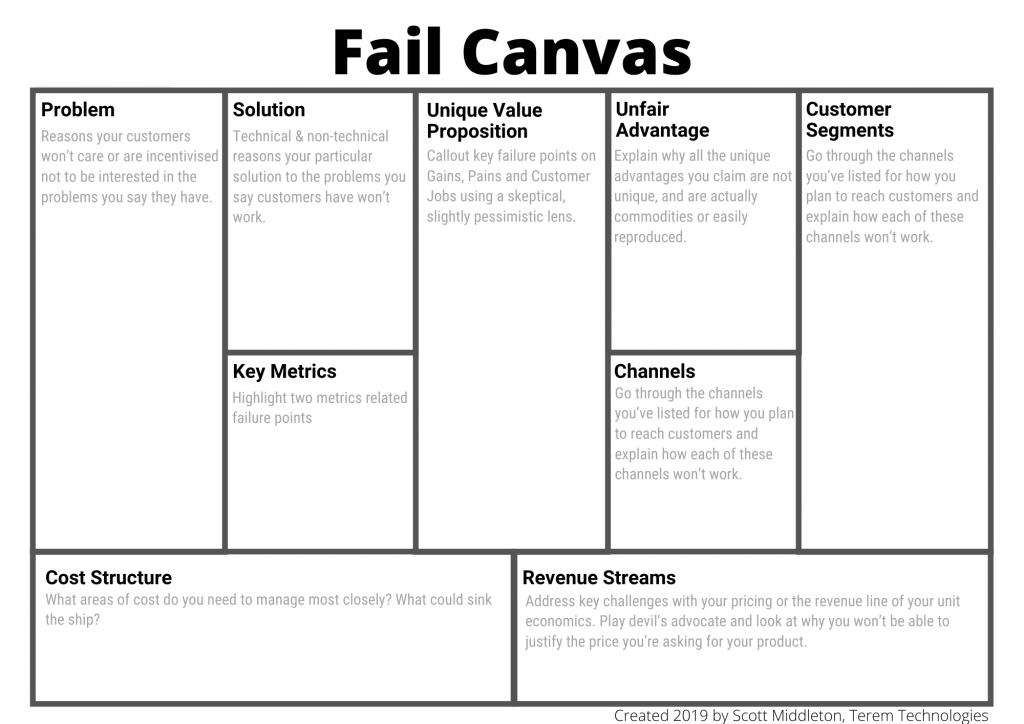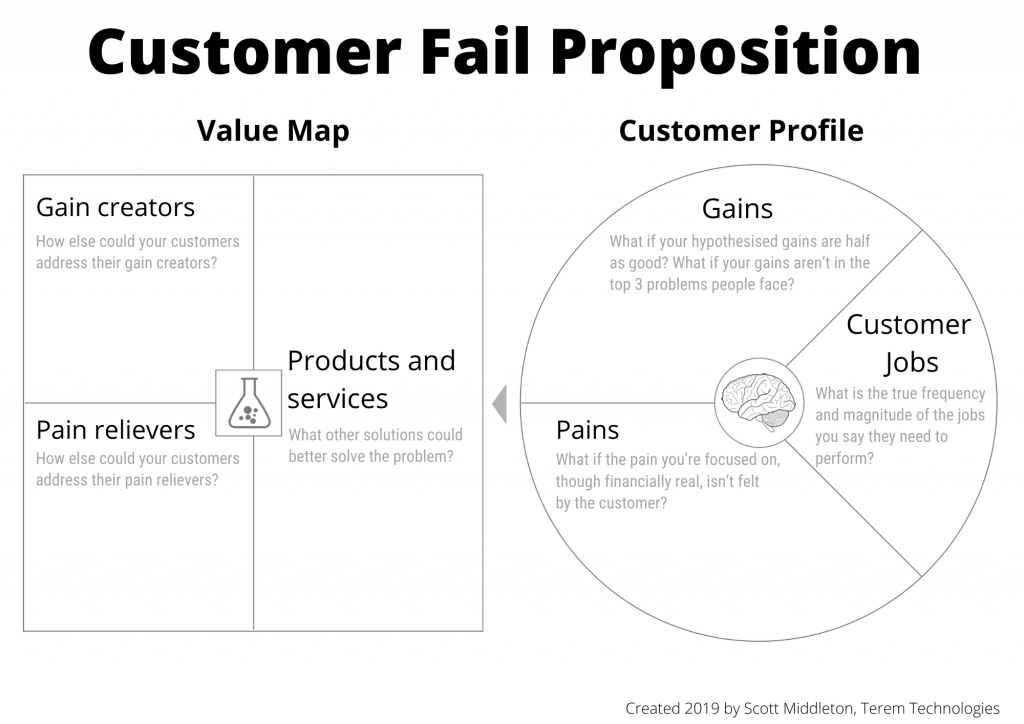
Lean Canvas is a widely known and available tool for assessing product and business ideas, as is Design Thinking and other design processes as well as Agile, Lean Startup, and the Customer Value Proposition (CVP). Why then do so people get product and business ideas wrong?
Well, it’s because they don’t do the Fail Canvas, or the Customer Fail Proposition. Basically, they don’t look at why they will fail. Everyone thinks they assess risk – I’ve been in meetings where a risk to a digital product succeeding was listed as “earthquake or other natural disaster means we can’t resource the people we need” but they didn’t list “customer doesn’t want our product because philosophically they disagree with our approach.”
That is, they were giving themselves false comfort that they had managed risks by listing random risks that came to mind, while failing to address market realities that ran counter to their ideas they were so enthusiastic about (or they’d backed themselves into a corner they couldn’t shift from without losing face/ego).
So how do you uncover the market realities that will kill your product’s success? Well I’ve come to love a tool I call the Fail Canvas. Basically you take everyone’s favourite product tools – the Lean Canvas and the CVP and invert them so you get the Fail Canvas and the Customer Fail Proposition.
Then with each tool you focus completely on what factors are present that work against your product. In a way, we’re borrowing from 6 hats thinking and giving ourselves permission to wear the fail hat rather than the optimist hat the environment encourages us to pretend to wear.
We aren’t doing this as some kind of weird desire to wallow in failure, but rather because this exercise is how you take your product to the next level.
Before you get started, you do need a normal Lean Canvas completed.
Let’s go through what these look like.
Fail Canvas
Problem – list the reasons you think your customers won’t care or are incentivised not to be interested in the problems you say they have. Focus specifically on the problems, not necessarily your solution to their problems.
Solution – list the reasons your particular solution to the problems you say customers have won’t work. List the technical reasons but also be sure to list non-technical. A technical reason would be “it’s just not physically possible to reduce flight times between New York and London to 5 seconds” and a non-technical reason might be “a slack message isn’t the delivery format people want to receive a 10-page report in”.
Key Metrics – this is where you want to highlight two metrics related failure points: (a) why you won’t be able to obtain the metrics you need (e.g. it’s too hard to measure/prove that your staff coffee organiser app improves well-being by 100% and that links to profit increases). (b) why the metrics you say you need aren’t actually indicators of success for you or your users.
Unique Value Proposition – see the Customer Failure Proposition tool below.
Unfair Advantage – explain why all the unique advantages you claim are not unique, and are actually commodities or easily reproduced. Here I’m reminded of a tutorial from University on market strategy where a student strongly argued the case that Nike’s competitive advantage was that it had celebrities endorsing it. The fail side of this is: anyone can get a celebrity to endorse them, just throw cash at it, cash is somewhat easy to come by.
This is where you look closely at your competitors, assume they are smarter than you and assume they will continue to improve at a faster pace than you might be able to.
Channels – go through the channels you’ve listed for how you plan to reach customers and explain how each of these channels won’t work or resonate. Get specific on the reasons for why it won’t work.
Customer Segments – The ways your segmentation can fail are: too small, too many, not addressable/accessible, too broad. Also make sure you’ve talked about phasing/staging these segments appropriately (see customer adoption curve). Make a list of the ones you think might apply to you.
Cost Structure – which parts of your cost structure will sink the ship? What areas of cost do you need to manage most closely? Look at Unit Economics but also look closely at your main costs as well as potentially hidden costs (the last one is easy to say, harder to find until you get into it).
Revenue Streams – this is where you want to address key challenges with your pricing or the revenue line of your unit economics. For example, in consumer facing digital businesses there is the recurring theme of “if we get 1,000,000 paying us $5 we’ll make $5m!” that needs to be countered with “what does the curve look like to get to 1m paying customers? Does that structure work?” This is also where you play devil’s advocate and look at why you won’t be able to justify the price you’re asking for your product.

Customer Fail Proposition
The Customer Fail Proposition, like the Fail Canvas, is about inverting the Customer Value Proposition to callout key failure points. Put your devil’s advocate hat on.
With the Customer Fail Proposition Canvas you take your CVP Canvas and, instead of being optimistic, you use a skeptical, slightly pessimistic lens.
Let’s walk through each aspect of the Value Proposition Canvas and discuss how it can go wrong. This is actually hard work.
Customer Profile
Gains – what if your hypothesised benefits are half as good? What if your benefits aren’t in the top 3 problems people face? Additionally, pain is often easier to sell than gain. If all you have is gains, then you might be in trouble.
Pains – what if the pain you’re focused on, though financially real, isn’t felt by the customer? Isn’t felt by the buyer? In B2B, a common theme is that people mistake company pain for an individual’s pain. In most companies, individuals are spending someone else’s money so this isn’t painful for them if it helps them hit their KPIs.
Customer jobs – what is the frequency and magnitude of the jobs you say they need to perform? Have you observed your customer or lived in their shoes for a week/day? People might tell you one thing, but then watching over their shoulder reveals other jobs or the reality of the job they are doing.
Value Map Your Solution
Be skeptical about your solution here. How else could your customers address their problems and opportunities? Is your solution really the best way to address the problem?
Now you’ve worn the fail hat, you should have a much clearer view of the risks and whether your product or business idea is really as solid as you initially thought.